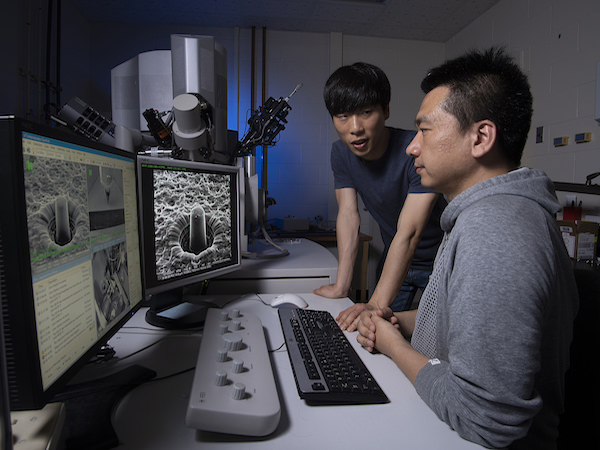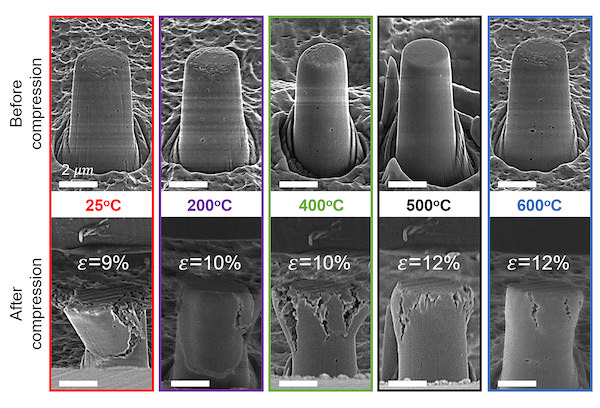
[Image above] Purdue researchers observed for the first time how ceramics formed under an electric field surprisingly change shape rather than break when compressed at high strain. Pictured: Graduate research assistants Jaehun Cho and Qiang Li. Credit: Purdue University
Ceramic materials typically have high melting points, low ductility, and are very brittle. Which makes them excellent materials for high-temperature applications in industries such as transportation and energy, but not so much when used in applications requiring heavy loads—such as jet engine blade coatings.
And if you attended the Mechanical Properties of Ceramics and Glass short course at ICACC18 earlier this year, you would have heard experts discuss properties such as stress, strain, elasticity, and fracture toughness of ceramics—and the challenges that arise for some applications.
While materials such as ceramic matrix composites are being used in turbine engines, one challenge remains for ceramic materials used as thermal barrier coatings on metal engine blades: The tendency to crack and break under strain during lower temperature ranges.
But maybe not for much longer.
Researchers at Purdue University (West Lafayette, Ind.) demonstrated that yttria-stabilized zirconia (YSZ) acquires metal-like plasticity at room temperature when an electric field is applied during sintering. Because it can be reshaped while in this state, cracks would propagate slower, providing engineers with extra time to fix the component, according to a Purdue University news release.
“In the past, when we applied a high load at lower temperatures, a large number of ceramics would fail catastrophically without warning,” professor of materials engineering Xinghang Zhang explains in the release. “Now we can see the cracks coming, but the material stays together; this is predictable failure and much safer for the usage of ceramics.”
Flash sintering, which uses electric fields to accelerate the sintering process, is not a new technology. In fact, we’ve reported on it here on Ceramic Tech Today as well as here and here. But the Purdue researchers were the first to actually test how flash-sintered ceramic materials change shape at various temperatures.
Defects or dislocations in metals allow them to change shape and resist fractures, according to graduate research assistant in materials engineering Jaehun Cho. “These dislocations will move under compression or tension, such that the material doesn’t fail.”
Dislocations don’t typically form in ceramics unless they’re flash sintered, resulting in smaller grain size, which helps the ceramic material deform better, explains Basil S. Turner Professor of Engineering Haiyan Wang in the release.

Applying an electric field to ceramics during their formation gives them the metal-like characteristics needed for sustaining heavy loads without sudden collapse. Credit: Purdue University/Jaehun Cho
When compared to a regularly sintered sample of YSZ that needs 800o C to deform plastically, the flash-sintered sample only required up to 600o C to deform and showed high compressive strength below 400o C, according to the paper’s abstract.
And that means more stability at lower temperatures—and a key improvement in a critical property for aircraft engine thermal barrier coatings.
“Metals can be compressed to 10 or 20 percent strain, no problem, but ceramics often fracture into pieces if you compress them to less than 2–3 percent strain,” Zhang adds in the release. “We show that flash-sintered ceramics can be compressed to 7-10 percent without catastrophic fracture.”
The open access paper, published in Nature Communications, is High temperature deformability of ductile flash-sintered ceramics via in-situ compression (DOI: 10.1038/s41467-018-04333-2).
Do you want to learn more about flash sintering? Register for The Science and Technology of Flash Sintering of Ceramics half-day short course at MS&T18, October 18, 2018, in Columbus, Ohio. Check out the course description and register at this link.
Want to read more articles like this? Subscribe to the Ceramic Tech Today newsletter to continue to receive the latest news in the ceramic and glass industry right in your inbox! Visit this link to get started.
